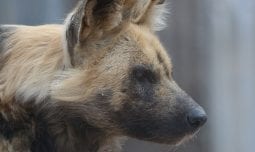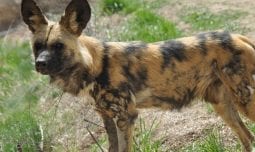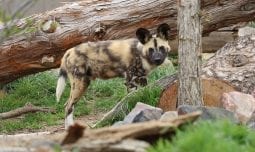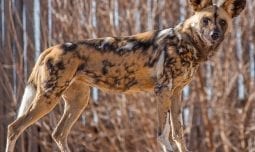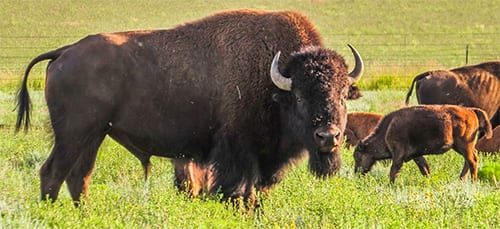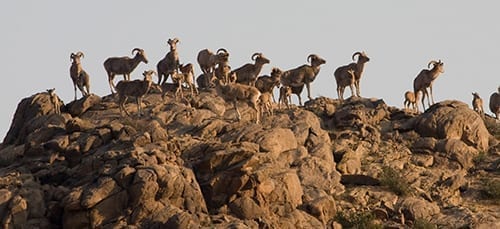Classification
Class Mammalia
Order Carnivora
Family Canidae
Genus Lycaon
Species pictus
Habitat & Range
Wild dogs inhabit grassland, savannah, open woodlands and montane regions.
African wild dogs were historically found from the Sahara to South Africa, but are currently more limited in range.

African Wild Dog
Lycaon pictus
Wild dogs do not have big powerful jaws like cats so they cannot bring down large animals alone. Hunting in a pack requires cooperation among pack members, this enables wild dogs to bring down animals five times their size. Wild dogs hunt mainly at dawn and dusk because they use their sense of sight to find prey. They usually approach silently, pursue the fleeing prey until it tires, and then attack and kill the animal. Their mottled coloring also aids in hunting by making the pack appear larger than it is!
Adaptations
Speedy Pursuit
African wild dogs have tremendous endurance running at speeds of 37 mph for three miles or more pursuing prey. As their prey tires, it is easier to catch. Their long legs and large lungs help them run long distances without tiring. Their speed and endurance as well as the pack structure make them very successful predators… they are successful 70-90% of the time!
My What Big Ears You Have!
The characteristic large, round ears of the African wild dog have a double purpose. They have excellent hearing for hunting prey, and their large ears help cool the dog off in the hot African climate.
Group Hunting
Wild dogs do not have big powerful jaws like cats so they cannot bring down large animals alone. Hunting in a pack requires cooperation among pack members, and this increases the success rate in capturing prey and enables wild dogs to bring down animals five times their size. Wild dogs hunt mainly at dawn and dusk because they use their sense of sight to find prey. They usually approach silently, pursue the fleeing prey until it tires, and then attack and kill the animal. All pack members share in the kill. Their mottled coloring also aids in hunting by making the pack appear larger than it is!
Physical Description
- Weigh between 40-80 pounds (18-36 kg); males and females are the same size.
- Weigh between 40-80 pounds (18-36 kg); males and females are the same size.
- Stand about 30 inches (76 cm) at the shoulder.
- Their short fur is brilliantly colored in splotches of black, deep brown, gold and white with a black muzzle.
- Their tail is relatively large and always tipped with white.
- They are long-legged and slender with a broad skull and large rounded ears.
Diet
What Does It Eat?
In the wild: Thomson’s gazelle, warthog, zebra, wildebeest, impala, springbok and the young of large antelopes.
At the zoo: A commercial meat product with high protein dog chow. Their food is fortified with vitamins and minerals. Treats include smoked pig ears and bones.
What Eats It?
Pups are preyed on by lions, hyenas and leopards.
Social Organization
African wild dogs are social hunters with an unusual pack system compared to other social mammals. A new pack forms when a pack of related females meets a pack of related males, thus the pack usually consists of seven to ten adults, consists of males who are related to each other and females who are related to each other but the males and females are not related. Only the dominant male and female reproduce but the entire pack is needed to help feed and protect the large litters of pups. The males of the pack are more numerous and frequently raise pups, though all adults regurgitate food for the pups while they are in the den. The dominant individuals within the pack take the most dangerous roles in the hunt and typically seize the prey. Pups present at a kill will eat first while adults defend the kill from scavengers.
Life Cycle
Sexual maturity is attained between 12 and 18 months. Typically only the dominant male and female in a pack produce offspring. Litter size averages 10 pups but can be as high as 20. The pups are born blind, and weigh less than a pound. Pups remain in their den (often an abandoned aardvark hole) for the first two to three months closely guarded by their mother with assistance from other pack members, often males. At about three weeks pups open their eyes, and are weaned at about 10 weeks. Pups begin eating regurgitated food at 4-5 weeks. African wild dog pups start to roam with the pack at about three months. All members of the pack provide food and protection for the pups until they are mature between 12-14 months, and pups typically stay with their pack into their second year. Most males will remain in their natal pack throughout their lives. Females between 14 and 30 months of age leave their natal pack in groups of littermate sisters and form a new pack with an unrelated pack of a group of related males. African wild dogs live about 10 years in the wild and in captivity.
Fun Facts
- African wild dogs are also referred to as Cape hunting dogs and Painted dogs.
- Wild dogs communicate with a series of wailing hoots to keep the pack together.
- Only the dominant male and female in a pack cock a hind leg when urinating. Subordinate animals in the pack urinate with all four legs on the ground.
- These wild dogs are Africa’s largest species of canine.
- African wild dogs are one of the most brightly colored of the 35 different canid (wild dog) species.
- In Latin, Lycaon picus means “painted wolf-like animal.”
- These dogs differ from wolves and other dogs by having 4 toes instead of 5.
Conservation Status
IUCN Status: Endangered
There are fewer than 5000 African wild dogs left in the wild. Their numbers have been reduced by habitat loss, direct persecution and disease. Wild dogs may contract diseases such as distemper or rabies from domestic dogs. Despite protective laws, wild dogs are still killed by herders to protect domestic livestock. Studies have shown that a pack needs between 80 and 800 square miles (207 – 2,070 km2) in which to roam and hunt. Sadly, most national parks in African are not large enough to support more than one pack.

Download the App!
Get the FREE Denver Zoo app today, and be a pro the next time you visit the Zoo. You’ll get access to the Zoo map, daily activities and schedules, animal facts, and more. You can even load your membership card onto the app for additional convenience. It puts everything you need for an amazing Zoo experience right into the palm of your hand!
